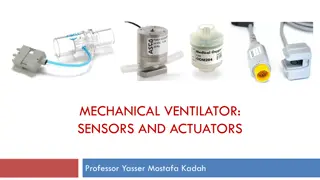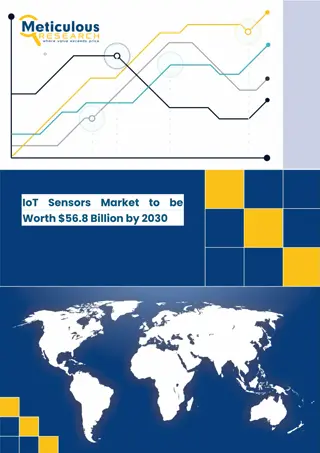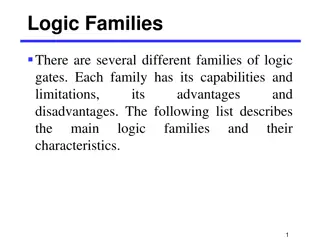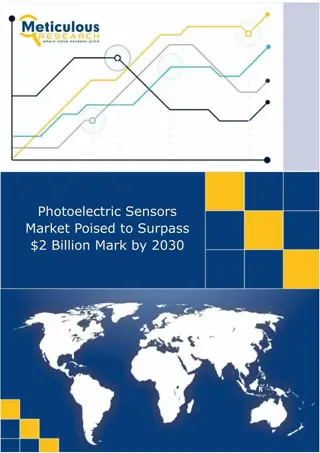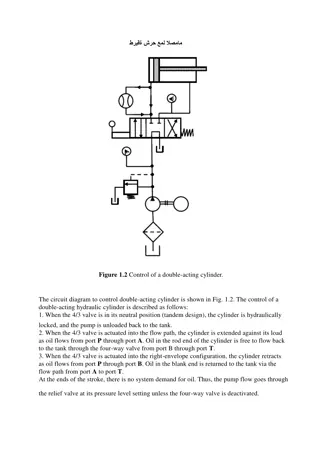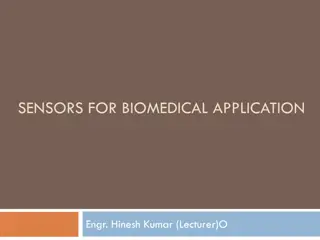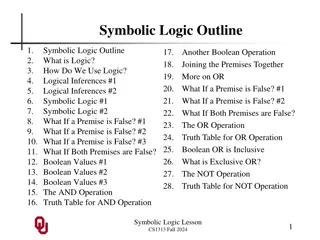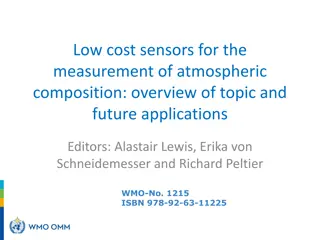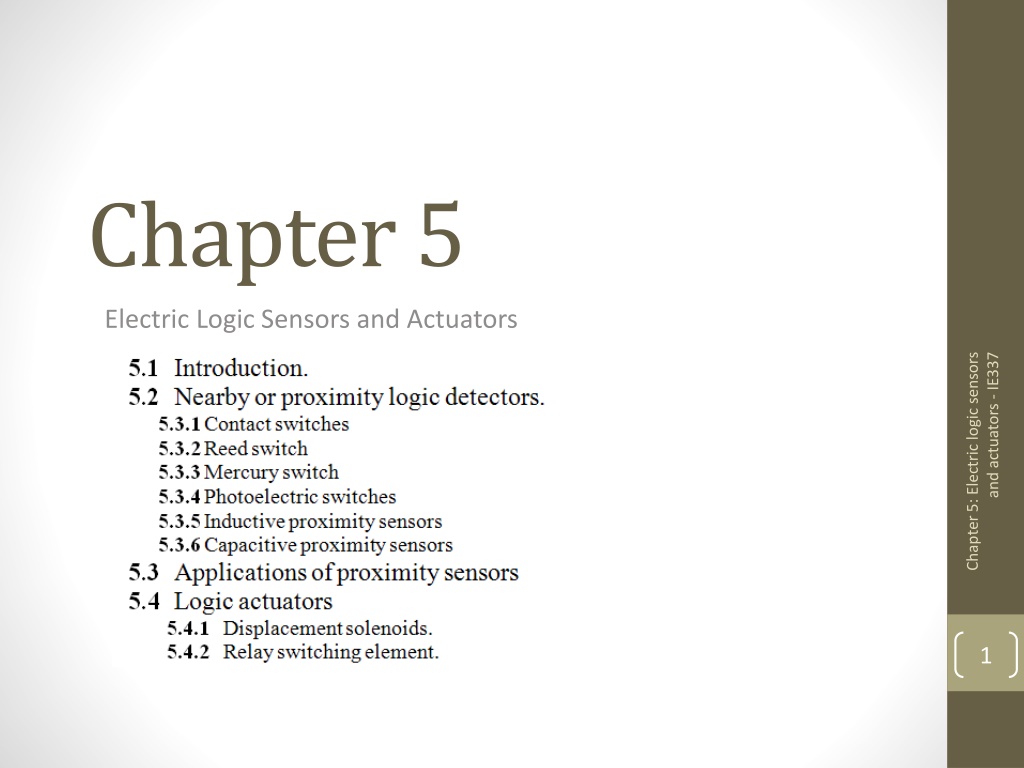
Electric Logic Sensors and Actuators Overview
Explore the classification of electric sensors and actuators into continuous and logic types, with examples of their applications such as detecting objects using optical sensors, capacitive detectors, and more. Learn about nearby or proximity logic detectors and contact switches in electric systems.
Download Presentation

Please find below an Image/Link to download the presentation.
The content on the website is provided AS IS for your information and personal use only. It may not be sold, licensed, or shared on other websites without obtaining consent from the author. If you encounter any issues during the download, it is possible that the publisher has removed the file from their server.
You are allowed to download the files provided on this website for personal or commercial use, subject to the condition that they are used lawfully. All files are the property of their respective owners.
The content on the website is provided AS IS for your information and personal use only. It may not be sold, licensed, or shared on other websites without obtaining consent from the author.
E N D
Presentation Transcript
Chapter 5 Electric Logic Sensors and Actuators Chapter 5: Electric logic sensors and actuators - IE337 1
Logic Sensors and Actuators Electric sensors and actuators can be classified as continuous or logic. Logic sensors have 2 states: 0/1, TRUE/FALSE, ON/OFF. Logic actuators are used with a PLC to activate or deactivate the logic switching elements, that will drive the mechanical system. Chapter 5: Electric logic sensors and actuators - IE337 Examples of using logic sensors: Mechanical limit switch used to detect an approaching object. Optical sensor or detector used to detect an object that is breaking the beam of light. Capacitive detector used to detect the existence of dielectric objects. Inductive detector switch used to detect the existence of a ferrous metal object. 2 A thermostat switch (such as those used in refrigeration and air conditioning) opens or closes a contact when a certain temperature is reached.
Continuous Sensors and Actuators Continuous sensors generate a continuous signal (voltage or current) that is proportional to the actual physical variable. For example, a linear potentiometer will generate analog output signal proportional to linear displacements. Continuous actuators are used to activate or deactivate to drive the mechanical system proportional to the value of the control signal. Chapter 5: Electric logic sensors and actuators - IE337 For example, the analog output signal from PLC can be used to activate a linear amplifier that will control the speed of a DC motor. 3 Linear Analog DC servo drives Linear potentiometer
Nearby or Proximity Logic Detectors There are two ways to detect the existence of an object: Physical contact: direct mechanical contact using a physical force contact No physical contact: using proximity technique Chapter 5: Electric logic sensors and actuators - IE337 4
Contact switches Internally, contact switches consist of electric contacts driven by mechanical lever and spring. Applying a small force on this mechanical liver actuates the contact. Removing the force causes the return of the contact to its original position. Chapter 5: Electric logic sensors and actuators - IE337 Contact switches are available with either normally closed NC or normally opened NO contacts. Micro limit switches can be found with small equipment, while heavy-duty limit switches (more expensive) can be found with large equipment. Contact switches can be used as motion limit switches or as push button switches and used as user-machine interface switches, e.g. start/stop push button switches. 5
5.2 Nearby or Proximity Logic Detectors Fig 5.1 Examples of contact switches used as limit switches. Chapter 5: Electric logic sensors and actuators - IE337 6 Fig 5.2 Examples of contact switches used as push-button, key type and selector switches used as machine-user interface buttons.
Configurations of contact switches Contact switches are of two types: single-pole single-throw (SPST) contacts. single-pole double-throw (SPDT) contacts, also called change over or transfer contacts. Chapter 5: Electric logic sensors and actuators - IE337 7
Drawbacks of contact switches It has been estimated that 90% of machine automation failures are from limit switches. In many automation applications, the limit switches represent the weakest link of the control system. This is because these sensors are located in the places where action is. These switches are usually located in hot areas, moisture, corrosive atmosphere etc. Chapter 5: Electric logic sensors and actuators - IE337 8
Capacitive proximity switches http://www.youtube.com/watch?v=SsvjxnN8ZUk Not limited to metallic targets (non ferrous, also called dielectric materials): liquid, water, oil, powder, wood, plastic, etc. Can detect objects inside sealed containers Change in capacitance causes the circuit to actuate a solid state switch Maximum sensing distances range from 5 to 40mm Switching accuracy affected by humidity and temperature Low responses to detect high speed moving objects compared to inductive sensors Chapter 5: Electric logic sensors and actuators - IE337 9
Inductive proximity switches http://www.youtube.com/watch?v=dZKesqSYtZA&list=PL3D1192AC 1FFB36DF&index=5 An inductive sensor is an electronic proximity sensor, which detects metallic objects without touching them. The sensor consists of an induction loop. Electric current generates a magnetic field, which collapses generating a current that falls asymptotically toward zero from its initial level when the input electricity ceases. This change can be detected by sensing circuitry, which can signal to some other device whenever metal is detected Common applications of inductive sensors include Metal detectors Traffic lights Car washes Applications where dirt is prevalent. Chapter 5: Electric logic sensors and actuators - IE337 Elements of a simple inductive sensor. 1. Field sensor 2. Oscillator 3. Demodulator 4. Flip-flop 5. Output 10
Photoelectric switches Photoelectric sensors consist of a source emitting a light beam and a light-sensing detector receiving the beam. The object to be sensed interrupts or reflects the beam, thereby making its presence known without physical contact between sensors and object. Chapter 5: Electric logic sensors and actuators - IE337 3 possible modes of operation Through-beam Reflection from target Retro-reflection 11
Through-beam photoelectric sensor The emitter and detector are mounted in separate housings which are aligned carefully so as to face each other exactly. As the target to be detected approaches, it breaks the beam. In this type of operation the sensor can work for lengths up to 100m, provided the beam is concentrated and the air is clean. An interesting variation of the through-beam principle can be used as smoke detector (such as in domestic fire alarm). Chapter 5: Electric logic sensors and actuators - IE337 12
Reflectionfromtarget The emitter and detector are built into a single housing, which reduces wiring and mounting cost. When the target reaches the proper location, it reflects the beam back into the detector. This mode is only suitable for fairly small distances, where the air must be reasonably clean of contamination. The method can be used for detecting the liquid level. Chapter 5: Electric logic sensors and actuators - IE337 13
Retroreflection A special reflector (typically a formed plastic surface with small embedded spheres or pyramids) reflects the light beam back into the detector, regardless of the angle of incidence, unless the target interrupts it. The emitter and detector are mounted on the same housing. This method can be used to sense a distance up to 10 m in the absence of atmospheric contaminations. Chapter 5: Electric logic sensors and actuators - IE337 14
Reed switches The reed switch is an electrical switch operated by an applied magnetic field. It consists of a pair of contacts on ferrous metal reeds in a hermetically sealed glass envelope. The contacts may be normally open, closing when a magnetic field is present, or normally closed and opening when a magnetic field is applied. The switch may be actuated by a coil, making a reed relay or by bringing a magnet near to the switch. Once the magnet is pulled away from the switch, the reed switch will go back to its original position. An example of a reed switch's application is to detect the opening of a door, when used as a proximity switch for a burglar alarm. Chapter 5: Electric logic sensors and actuators - IE337 15
Mercuryswitches A mercury switch (also known as a mercury tilt switch) is a switch which opens and closes an electrical circuit through a small amount of liquid mercury. Mercury switches have one or more sets of electrical contacts in a sealed glass envelope which contains a bead of mercury. The envelope may also contain air, an inert gas, or a vacuum. Gravity is constantly pulling the drop of mercury to the lowest point in the envelope. When the switch is tilted in the appropriate direction, the mercury touches a set of contacts, thus completing the electrical circuit through those contacts. Tilting the switch the opposite direction causes the mercury to move away from that set of contacts, thus breaking that circuit. Chapter 5: Electric logic sensors and actuators - IE337 16
5.3 Applications Nearby or Proximity Logic Detectors (a) (b) (c) Chapter 5: Electric logic sensors and actuators - IE337 (d) (e) (f) a) Capacitive type. b) Retro-reflection optical. c) Retro-reflection optical. (i) (h) d) Inductive type. e) Inductive or capacitive l) Thru-beam optical type. m) Thru-beam type. n) Inductive (steel cans) or reflection from target optical type. f) Capacitive. 17 g) Retro-reflection or thru-beam. h) Capacitive. i) Inductive. j) Capacitive or thru-beam. k) Thru-beam
5.3 Applications of Nearby or Proximity Logic Detectors (i) (h) (g) Chapter 5: Electric logic sensors and actuators - IE337 (l) (k) (j) (m & n) l) Thru-beam optical type. m) Thru-beam type. n) Inductive (steel cans) or reflection from target optical type. g) Retro-reflection or thru-beam. h) Capacitive. i) Inductive. j) Capacitive or thru-beam. k) Thru-beam 18
Actuators An actuator is a type of motor for moving or controlling a mechanism or system. An actuator is the mechanism by which a control system acts upon an environment. It is operated by a source of energy, and converts that energy into motion. Typical energy: Electric current, Hydraulic fluid pressure, Pneumatic pressure Logic actuators Solenoids Relay switches Electromechanical relays Reed relays Solid state relays Chapter 5: Electric logic sensors and actuators - IE337 19
Solenoids The majority of the solenoids generate force only in one direction and they are used as on-off actuators Solenoids are simple and cheap linear actuators Widely used in the construction of contactors, circuit breakers, and solenoid valves. The operation of solenoids is based on conversion of electrical energy into mechanical energy, and therefore solenoids are being considered as electromechanical actuators. Chapter 5: Electric logic sensors and actuators - IE337 20
Solenoidfeatures Type of displacement: linear or angular Actuation type: push or pull Stroke: range of displacement in mm (linear) or degrees (angular) Force or torque Duty cycle f: Chapter 5: Electric logic sensors and actuators - IE337 Life time: standard life is 50,000 to 100,000 operations Environment conditions: sensitivity to temperature and humidity Performance curve: Force = F(Stroke) 21
Performance curveof a solenoid Chapter 5: Electric logic sensors and actuators - IE337 22
Example: sizinga solenoid Consider a linear solenoid with the following specifications: ON time: 20 sec. OFF time: 150 sec. Working stroke : 5 mm Pull force : 10 N Chapter 5: Electric logic sensors and actuators - IE337 Determine duty cycle and select one of the following solenoids according to their performance curves 23
Duty cycle: Working stroke : Pull force : 5 mm 10 N Solenoid-C will not provide the required linear displacement (maximum displacement 3.81 mm). Chapter 5: Electric logic sensors and actuators - IE337 Both solenoids A and B provide the required displacement at duty cycle 11% However, solenoid A provides much greater force (52N) then required (10N). Solenoid B provides the required force and displacement at the calculated duty cycle. 24
Relay switches A relay is an electrically operated switch Relays are used as : current or voltage amplifiers (i.e. power relays) electric isolation between the control signal (i.e. coil) and the output load (i.e. contact). logic switching elements to control a high power circuit by a low- power signal (i.e. control relay) multi-contact relay, where one input signal is used to control many different loads (possible with different voltages for each load) Chapter 5: Electric logic sensors and actuators - IE337 There are three basic relay types: Electromechanical Reed Solid-state 25
Electromechanicalrelays(EMR) When an electric current is passed through the coil it generates a magnetic field that activates the armature The consequent movement of the movable contact(s) either makes or breaks (depending upon construction) a connection with a fixed contact. When the current to the coil is switched off, the armature is returned by a force to its relaxed position. Usually this force is provided by a spring, but gravity is also used commonly in industrial motor starters. Most relays are manufactured to operate quickly. In a low-voltage application this reduces noise; in a high voltage or current application it reduces arcing. Chapter 5: Electric logic sensors and actuators - IE337 26
Reed relays A reed relay is a reed switch enclosed in a solenoid. The reed switch contacts are made of magnetic material that makes them move under the influence of the field of the enclosing solenoid. Reed relays can switch faster than larger relays and require very little power from the control circuit. However, they have relatively low switching current and voltage ratings. Though rare, the reeds can become magnetized over time, which makes them stick 'on' even when no current is present Chapter 5: Electric logic sensors and actuators - IE337 27
Solidstate relays(SSR) A solid state relay (SSR) is a solid state electronic component that provides a similar function to an electromechanical relay but does not have any moving components, increasing long- term reliability. Chapter 5: Electric logic sensors and actuators - IE337 28
SSR features Advantages Drawbacks SSR switch is much faster than EMR and has quite operation. Their initial cost is greater that EMR The life of SSR is nearly infinite compared to EMR life. They can switch only one circuit, hence, muti-SSR required to switch multi-loads They are not good as positive shutoff devices, since they have a leakage current SSR usually fail in the on state, which is quite dangerous. Chapter 5: Electric logic sensors and actuators - IE337 SSR can be switched using low power electronic devices (gates) Resistance for shocks and vibration compared to EMR The application of SSR is not forward like EMR; for example, two types of SSR are used for DC and AC load. 29 SSR are not suitable for very high temperature operation.
Problems 5-1) Complete the following statements: Sensors can detect the ..or . Of objects. (ans: presence,absence) The three main sensor categories are: .., ., . (ans: contact switches, proximity sensors, photoelectric sensors). The sensor type that can only detect metallic objects is the sensor (ans: inductive type) The sensor type that uses a broken beam of light to detect objects is commonly referred as a .. sensor. (ans: photoelectric type). Inductive proximity sensors work best with .. metals. (ans: Ferrous) The transparency of the container has no effects on the sensing of .. sensors. (ans: Capacitive) The initials designating a transistor output that sinks current from the load are The initials designating a transistor output that sources current to the load are . 5-2) State the main difference between the electromechanical and solid-state relays, what are the advantages and Drawbacks of both devices? Chapter 5: Electric logic sensors and actuators - IE337 (ans: NPN) (ans: PNP) 5-3) What are the differences between Load-Power Sensors and Line-Powered Sensors? 5-4) State the main difference between NPN and PNP sensor output signals, sketch the two output circuits? 30


